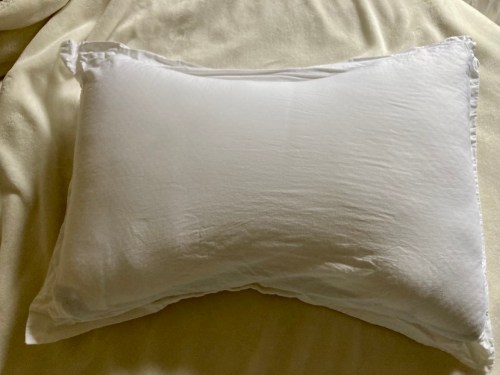Our editors independently select these products. Making a purchase through our links may earn Well+Good a commission
Here’s What Happened When I Tried an Adjustable Pillow for Side Sleepers (That Promises Less Pain and Better Rest) for One Month
There are numerous pillows on the market for each type of sleeper. When one writer tried Eli & Elm's Side Sleeper Pillow, she slept soundly.

There are so many components that go into a good night’s sleep. Besides making sure you’re actually getting enough, it’s key to try to make that sleep as restful as possible, too. A key piece of that is your sleep environment: how dark, cold, and quiet your room is goes into this—even your bedding, including your mattress and pillows. As someone who sleeps on their side predominantly, I find myself waking up with achy shoulders and hips sometimes, so I’m all ears for anything to remedy that stiffness. I hadn’t even considered swapping my pillow for one specifically designed to benefit side sleepers, so I knew I had to try it out when presented with the chance.
Experts in This Article
sleep doctor and assistant clinical professor at Keck School of Medicine of USC
sleep technician and founder of Sleep Mattress HQ
There are numerous pillows on the market for seemingly every preference a shopper could have. Pillows for back sleepers, pillows for stomach sleepers, pillows for combination sleepers, maternity pillows—the pillow options these days are endless. I personally used to sleep with two polyester-filled pillows stacked on top of another, but have since stopped because I found my neck was too sore from flexing all night—those pillows were too high. Now, I try to strike a balance between being flat enough to keep my spine and neck aligned and cushioned enough to be comfortable by sleeping on one flat pillow. However, I find that I still toss and turn some nights because my shoulder feels sore, and I often scoot lower to avoid it hitting my pillow and raising my neck. It can also feel like I’m sliding around on the pillow too much, which I think contributes to my sore shoulders and neck.
When Eli & Elm conveniently reached out about their Side Sleeper Pillow ($135), I was keen to see if this pillow’s unique shape would provide relief to my sore shoulders. Made from organic cotton and latex and polyester filling, the pillow has a curved shape on the bottom that fits around the shoulder. The pillow’s firmness is also adjustable, and it has a zipper that goes all the way around it to make adding or removing filling easy. After a month of sleeping on this pillow, I can say that it has helped ease me to sleep faster, and that I’ve been waking up with shoulders that are significantly less sore.
Eli & Elm Cotton Side-Sleeper Pillow
Eli & Elm, Cotton Side-Sleeper Pillow — $135.00
Originally $145, now $135
This pillow has an indentation to fit the shoulder and conform to the head and neck. Its height and firmness can also be adjusted, and it’s made from organic cotton.
Colors:1
Size: 17 inches by 29 inchesCover material: CottonFill material: Latex, polyester
Pros:
- Shape accommodates shoulder well
- Adjustable height and firmness
- Hypoallergenic
- Washable cover
- Organic materials, OEKO-TEX certified
Cons:
- Expensive
- Semicircular shape makes it hard to find pillowcase with exact fit
What makes a good pillow for a side sleeper
According to pulmonologist and sleep specialist Raj Dasgupta, MD, the best type of pillow for any sleep position is one that is supportive of the neck and spine, and that keeps them in alignment throughout the night. “If you’re sleeping on your side, you want a pillow that keeps your neck and spine aligned so your neck doesn’t flex upwards or downwards,” he says. He says that beyond ensuring good alignment of the neck and spine it’s difficult to make generalizations about the best types of pillows because particulars like exactly which material and firmness to choose are so specific to each individual’s preferences.
However, in addition to making sure the neck and spine are supported, pillows for side sleepers in particular also should account for the added pressure on the shoulders and hips during the night. This means making sure the pillow strikes a balance between being firm enough to provide cushioning and support, so the neck, spine, and shoulders don’t droop out of alignment, and are soft enough to be comfortable. “Side sleepers should choose pillows that are firm enough to align their head and neck with their spine, yet cushioned enough to alleviate pressure points on their shoulders and necks,” Susan Miller, RPSGT, a certified sleep technician at SleepMattressHQ.com, previously told Well+Good. This is key, and I can speak from experience—I’ve slept on my fair share of too soft pillows and woken up with the shoulder pain to prove it.
“If you’re sleeping on your side, you want a pillow that keeps your neck and spine aligned so your neck doesn’t flex upwards or downwards.”—sleep specialist Raj Dasgupta, MD
It’s important to note that if you’re truly having issues with pain while sleeping, your pillow likely isn’t the culprit (and you should make an appointment with your doctor or health care provider if you haven’t already). Dr. Dasgupta says that sleep hygiene fixes, which include things like changing your sleeping surface or setting a digital curfew before bed, can only go so far. If your discomfort is disrupting your sleep and ability to function in your daily life, speak with your doctor so they can examine you for underlying illness, injury, or a sleep disorder.
What happened when I slept on the Eli & Elm Side Sleeper Pillow for one month
The pillow
When I opened my box, I was intrigued by the pillow’s shape. The top edge is much straighter than the bottom, which has a pronounced contour. The pillow’s exterior is soft cotton and it’s medium-firm to the touch. Its dimensions are 17-inches by 29-inches, so it felt comparable to the pillows I had on my queen-sized bed. When I rested my head on the pillow initially, I was pleasantly surprised by how supported both my neck and shoulders felt; the center of the pillow sinks in more than the sides, so my head and neck felt cushioned and supported.

My package also arrived with a cotton pillowcase, which had a curved bottom to match the pillow, and a bag of extra filling. So far, the pillowcase has maintained its softness after a month of washes; however, it costs extra and doesn’t normally come with the pillow. The pillow did somewhat fit one of my other rectangular pillowcases, but the gap where the contour is was noticeable, so that’s something to consider because the pillowcase is sold separately (it’s 20 percent off on Amazon right now—you can snag it for $24). You also have the option to buy the pillow with the pillowcase for $140.
Although the pillow was firm enough for my liking out of the box, I decided to add some extra filling anyway. After carefully cutting open the bag of extra latex noodle filling, I unzipped the pillow’s cover and stuffed more inside to make it slightly firmer. Doing so was easy and mess-free. With everything in place, I was ready to start snoozing on this pillow for side sleepers.
Testing the Eli & Elm Side Sleeper Pillow
To truly test how well this pillow treated my shot shoulders, I slept on this pillow every night for one month. I banished my other pillows from my bed, except for the one I tuck between my knees to help keep my spine aligned near my hips, and kept all my usual sleeping conditions the same including the rest of my bedding. Besides this pillow, the only other items on my bed were my cotton sheets, wool blanket, and cotton bedspread.
It took a couple days to get used to the shape of this pillow, but the curved bottom did contour to my shoulder nicely. I was pleased with the firmness, and I didn’t emerge from bed in the mornings with a stiff neck. Most of all, I was happy to wake up without shoulder pain—it was still there on some days, but it definitely wasn’t as frequent and pronounced as before using the pillow.
The pillow maintained its firmness, and I only added more filling one time during the month to get a little more height on the pillow because I had a cold and had to elevate my head a bit more to breathe. Even so, I’m pretty sure my neck and spine remained aligned, and the pillow felt comfortable and breathable still. I’m not a hot or cold sleeper necessarily, and I did notice that the pillow seemed to not get too hot which I appreciated.
While I did still toss around during the night a bit still (Dr. Dasgupta says it’s common for people to switch sleeping positions during the night), the shape of the pillow definitely helped to limit it. The feeling of sliding off the pillow was gone, too; I noticed that it was actually a bit harder to turn and move around with this pillow, which really did cushion my neck and shoulders.
Overall, I’m happy with Eli & Elm’s Side Sleeper Pillow, and will continue to use it to keep shoulder pain away.
Sign up for the Well+Good SHOP Newsletter
Get exclusive deals on wellness, beauty, fitness, and food products that have been hand-picked by our editors.
Got it, you've been added to our email list.










